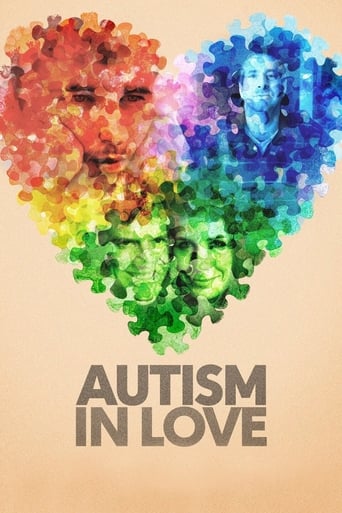pmvl
I just saw this movie and I found it to be a very powerful and tender documentary about love and autism. It shows how having autism (or being autistic) does not mean that one cannot fall in love. However it does make it more difficult. Also, one might say that the experience of might be different than the neurotypical experience (isn't everyone's experience different anyway?). Nonetheless, it is undeniably love.I feel compelled to write this review in response to the one by John Babak Ebrahimian. I would like to point out the following: -- This is a documentary about adults, not children. One of the adults is a young adult (in his 20s), there is a couple in their 30s, and another one who is older. None are children.-- This is not about friendship, it is about love. The romantic relationships depicted in the documentary are exactly that: romantic relationships, not just friendship.
Greg I Hamilton
The film opens with definitions of autism and of love that seem utterly at odds. Then the title 'Autism in Love' appears between them, an attempt to bridge seemingly irreconcilable forces.I had the pleasure of seeing Matt Fuller's excellent film through a PBS 'Indie Lens Pop-Up' screening here in our little community. It sparked enthusiastic conversation from people in the crowd. The film successfully bridged education, inspiration, and entertainment. It let us into the lives of a surprising variety of people on the autism spectrum, giving us an intimate sense of their struggles and their triumphs.I really appreciated the diversity of ages and life stories of the three main sets of characters. There's Lenny, a troubled young man who confronts the challenges of finding love with adolescent fire. Then there are Lindsey and Dave, a couple in their 30s bravely grappling with what might be a sustainable romantic relationship--if they can live with the extra set of challenges autism brings to the eternal dance of male versus female energy. And finally Stephen, who faces a later chapter in his life than the other characters, has found the love of his life ... only to confront her terminal illness.Through each set of characters we see a unique human story: different steps on different paths toward love. But woven together, their stories provide a wonderful lens into the universal challenge of finding and sustaining love. Viewers must watch carefully but they will be rewarded with evidence that all of these characters, against the obstacles of their autism, are able to feel, live, long, and love like anyone else on this planet.Fuller does a nice job of capturing and sharing the story with well-crafted camera-work and editing. One quiet scene that sticks in my mind is Lindsey, gliding alone up an escalator while a crowd of presumably "neurotypical" people make their way down a broken escalator in the background. That's an example of the rewards of watching this film closely for its subtle, elegant moments.
Karen Meyer
I was able to view this at the Bentonville Film Festival and I found it to be one of those films you don't forget.The story is a difficult one to tell, but Matt does a great job engaging the main characters, representing the various levels of the autism spectrum, and really making them 3 dimensional.He has done an amazing job with a challenging topic, and the movie really touches hearts, minds and spirit. I went through the emotional experience as he wove these people's lives, and ended up OK with the outcome. I hope he has some more ideas in the works, I would like to see his next films.
John Babak Ebrahimian
The director of the film has selected different autistic young adults who have "fallen in love", or are tying try to understand what "love"and"falling in love" means. The film also looks at the families behind the children in order to contextualize their history and progress of the condition. Going beyond the expository start of the film, the film's journey continues to document how each relationship between a young autistic man and a young autistic women results in a relationship or not. In some cases the relationship that the autistic couple have made is a strong friendship, in another a non-friendship, and in another a potential marriage.Beyond the vastly unexplored of the issue of the film -- regardless of age and religious and cultural background -- each subject reveals his or her personal relationship to their autistic condition. The film shows that despite the difficulty of the condition, each subject confront their autism with an understanding of having autism in their own way. In one scene we see and hear an autistic young man complain about his autism; he admits he wants to be "normal" just as his friends are at school; he elaborates on this by pointing out that his high school friends are all going to college but he can't do so. This personal confession shows how autistic people are aware of their condition in society and have emotion. In its final analysis, the film teaches us that we, as a society, need to be aware and compassionate of the autistic men and women.

